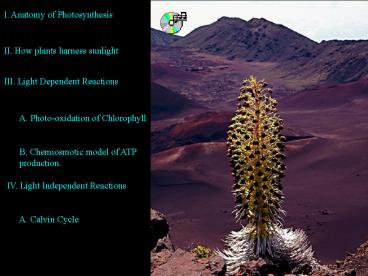III' Light Dependent Reactions - PowerPoint PPT Presentation
1 / 24
Title:
III' Light Dependent Reactions
Description:
During the Calvin cycle, CO2 is being reduced into sugar. CO2 ... CO2 is released from organic acids in the day and used in the Calvin cycle. The Silversword ... – PowerPoint PPT presentation
Number of Views:71
Avg rating:3.0/5.0
Title: III' Light Dependent Reactions
1
I. Anatomy of Photosynthesis
II. How plants harness sunlight
III. Light Dependent Reactions
A. Photo-oxidation of Chlorophyll
B. Chemiosmotic model of ATP production.
IV. Light Independent Reactions
A. Calvin Cycle
2
(No Transcript)
3
Non-cyclic Photophosphorylation
charge
pH 4
- charge
pH 8
4
Cyclic photophosphorylation
Make extra ATP
5
Turn to your neighbor and
Graph changes in pH of the thylakoid interior
over one 24 hr period. Indicate when ATP
production during the light reactions is zero.
Night
Day
Night
14
9
No ATP
No ATP
pH
7
4
1
6AM
6 PM
6
The Big Picture
What have we produced so far?
ATP
NADPH
CO2
provides the carbon and oxygen
provides high energy electron and H ions
provides the energy
Used to make energy rich sugar molecules during
the light independent reactions!
7
The Calvin Cycle
8
CARBON FIXATION
(3) CO2 molecules enter
Rubisco attaches the CO2 to RuBP
9
REDUCTION
6 ATP and 6 NADPH used
1 G3P molecule produced
10
Regenerate RuBP
Use 3 more ATP
11
And boy can plants fix carbon!
12
What do plants do with the sugars they make?
Fuel cellular respiration
most!
13
Similarities between photosynthesis and cellular
respiration
Chemiosmosis
Energy Coupling
Examples
14
Differences between cellular respiration and
photosynthesis.
Cellular Respiration
In CR electron carriers bring electrons to the
ETC, and O2 finally accepts them and is reduced
to H2O.
Photosynthesis
In photosynthesis H2O brings electrons to the ETC
and becomes O2, an electron carrier finally
accepts the electrons.
15
Differences between cellular respiration and
photosynthesis.
During the Calvin cycle, CO2 is being reduced
into sugar
CO2
During the Krebs cycle, sugars are oxidized and
become CO2
16
Photosynthetic Adaptations
What problems may a plant experience when it is
exposed to arid (dry) conditions?
Dehydration
Response
Close stomata to prevent dehydration
Elevated O2 levels in the leaves
17
Photorespiration
Rubisco an enzyme that catalyzes the addition
of CO2 to RuBP.
O2 competes with CO2 for the active site on
Rubisco.
Photorespiration
Calvin cycle sometimes called the C3 pathway
18
Rubisco
P G A
P G A
RuBp
CO2
Later becomes glucose!
Rubisco
P G A
RuBp
O2
Photorespiration these CO2s did not get
incorporated into glucose this time!
CO2
CO2
19
Photorespiration can lead to lower photosynthetic
output by siphoning carbon from the Calvin cycle!
They produce less sugar!!!
20
Turn to your neighbor and discuss the following
questions
1) What factor determines which reaction below
occurs more often?
- The concentration of rubisco
- The relative concentration of CO2 and O2
- The concentration of RuBp
Competing reactions
CO2
2) This is most similar to which of the
mechanisms of enzyme regulation we discussed
earlier in the semester?
2 molecules of 3-phosphoglycerate
rubisco
CO2 RuBP
21
Adaptations to arid climates
A) C4 plants - spatial separation of steps
B) CAM plants - temporal separation of steps
22
Leaf anatomy of plants adapted for hot/arid
conditions (C4 plants)
O2
C4 pathway
C3 pathway
Separate CO2 fixation and sugar making into two
different cells
23
CAM Plants - steps performed at different times
- Desert plantscacti, succulent plants,
pineapples
Organic acid
- Close their stomata during the day to minimize
water loss, and open stomata at night.
- At night they store CO2 in organic acids.
- CO2 is released from organic acids in the day
and used in the Calvin cycle.
24
The Silversword































